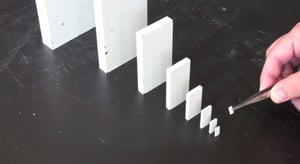
Today's article is about problem-solving when things appear to be overwhelming.
16 years ago, I had just made a huge move in my mortgage banking practice. My career started 7 years earlier when I was hired as an assistant to 2 high-level sales people who taught me the ropes and helped me get my life off the ground as a contributing person in the workforce. Before long I was on my own slinging loans in the suburbs of Washington DC for a smaller regional bank. I started making some inroads, built some key relationships, and felt that I was ready to join an organization with a nationwide banking presence, so I made the decision to join Wells Fargo Home Mortgage. My first day was Monday, April 3rd, 2000. I walked in the front door smiling from ear to ear. I was excited. I was bright-eyed and bushy-tailed and ready to get after it at my new company.
April 17th. A mere two weeks later would find me sitting behind my desk at 6:30 a.m. with my face in my hands, simply overwhelmed.
It was my birthday, but that didn’t really matter with the way I was feeling. I knew (or thought I knew) that I had made the right decision to change companies, but I was overwhelmed by… well, everything. The new company was just so big, and their systems were so different from anything I was familiar with, and their benefits were great but there were so many to choose from, and I had all these clients calling me for loans, but I found myself having no idea how to handle these leads because I had not gotten through all the training yet. I was so overwhelmed and out of my comfort zone, and I felt like I was forgetting all my prior top selling habits. And where were my business cards by the way? And why oh why was I working on my birthday?!
So there I was with my face in my hands, totally overwhelmed and frustrated, when my hiring manager, Mike Evans, walks by with a smile on his face and pokes his head in the door to say, “Good morning.” He took one look at me and knew that something wasn’t right, so he asked me how I was doing. The next 10 minutes are a blur of my verbally vomiting about how awful I was doing and how overwhelmed I was. But about 10 minutes in, he stopped me and said these words that I will never forget: “Jason, big problems have small solutions.”
Boom! That one little sentence hit me like a ton of bricks. I lifted my head out of my hands and listened for the next 15 minutes as he explained to me step-by-step what he meant. These step-by-step instructions have served me well over my career, and as I’ve adapted them over the years, I’ve been able to lead my team and my clients at Rewire to much success, regardless of the specific circumstances that have them feeling overwhelmed.
With the remainder of this article, I’d like to give you an overview of those steps. Just remember: you can solve big problems with small solutions.
Problem-solving Step 1: Make a decision to act
Until you make a decision to do something about the problem other than fret about it, nothing happens. This decision represents a line in the sand for yourself. No decision, no line, no solution. Make a decision to take action.
Problem-solving Step 2: Write out the facts and possible solutions
This step helps prevent you from going completely emotional on yourself like I was in the story above. To be clear, the problem isn’t emotions themselves; rather it’s when they act like a runaway train and hijack the rational thought processes that we would normally use to figure out solutions. It also helps in getting things out of your head and onto paper. And as long as we are on this topic of writing, my opinion is that you should write these facts out by hand (not typed into a device) because research has shown that when you are writing by hand, your brain is solely focusing on what is at the end of the pen and nothing else. When your brain is this focused, you are giving it power to also focus on possible solutions.
Problem-solving Step 3: Schedule when you will begin "solutioning" the problem
This step gives your solutions a time-frame and takes them from being a pipe dream in your head to actually happening in reality at a specific place and at a certain time. Specificity is a key in getting things done. Ambiguity is not. So get in on your hourly calendar.
Problem-solving Step 4: Start
We have written many articles on the power of starting something. Starting something, even when it’s not a great or perfect start, gets the momentum going and gets you that much closer to a solution. There's an old adage that it's easier to steer a moving car than a stationary one. And this idea definitely applies here: no start, no solution.
Problem-solving Step 5: Measure along the way
What gets measured gets done. As my friend Tony Horton asks in the P90x video series, “how do you know where you’re going unless you track where you’ve been?” It is much easier knowing what kind of progress you are making towards your solution when you are measuring along the way and either celebrating the path to the solution or making adjustments along that path.
Problem-solving Step 6: Make adjustments
If you notice in your measurements from step 5 that you are veering off course, this step ensures you make the necessary course corrections and continue on the path towards the solutions.
- how to make more sales,
- losing 100 pounds,
- rewiring your brain to actually enjoy nutritious foods,
- building a better relationship with your spouse,
- developing a new technology,
- or, like in my case above, being overwhelmed by starting at a new company.
I’ll close this article by saying that these 6 steps really do work. After my manager gave me “the talk” I described above, I went on to becoming one of Wells Fargo’s (and the nation’s) top mortgage bankers for several years running by using the “big problems have small solutions” system repeatedly. So I know it will work for you too. Give them a try and let us know how it goes. Our mindset coaches are experts at guiding you through this further.
----
P.S. If you'd like to read more about this idea, I'd highly recommend Chip and Dan Heath's Switch: How to change when change is hard. They talk more in-depth about the mental block I faced in this article. The block is that we assume that "big" problems require equally big or complex solutions. But as my colleague Mike shared, this isn't the case.
Speaking of Mike, I'd like to give a public thanks to Mike Evans for stepping in and getting me off the dime in April of 2000 (and helping the many who came after me with the same type of advice).





